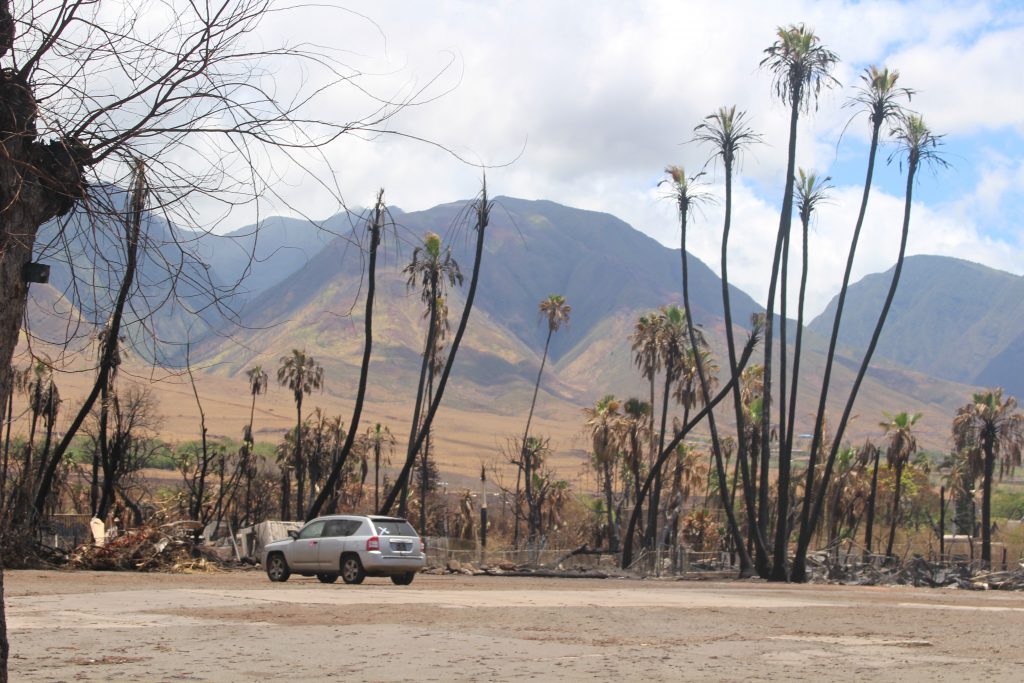Lahaina ash characterization testing shows elevated levels of toxic substances

The state Department of Health released data today showing elevated levels of arsenic, lead, antimony, cobalt, and copper in wildfire ash collected in Lahaina.
The ash samples were collected on Nov. 7-8, 2023 from 100 properties in Lahaina, which had been constructed from the 1900s to the 2000s.

DOH and its partners have consistently communicated that the wildfire ash and dust are toxic and should be avoided. The Lahaina data validates that the primary contaminant of concern is arsenic, a heavy metal that adheres to wildfire dust and ash. Department officials say this finding reinforces the need to diligently follow recommendations to reduce potential exposure.
“These data validate that the Lahaina ash contains toxic substances,” said State Health Director Dr. Kenneth S. Fink. “While the concentrations of these substances are lower than the Kula ash results, they are still elevated and it continues to be extremely important to take precautions. The risk remains greatest from ash ingestion. Inhaling disturbed ash and dust is also a potential route of exposure. We’ve been closely monitoring air quality in Lahaina and air sampling in Kula during debris removal which have been reassuring.”
People can take action to minimize their exposure to these contaminants including avoiding disruption of ash and wearing proper PPE when in impacted areas. In addition, for people near the impacted areas, keeping surfaces clean of dust and ash and frequent handwashing will greatly reduce potential exposure, according to the DOH
In October, when DOH received similar data showing toxic substances in Kula ash, DOH worked with the county and federal partners to take action to protect Kula and Lahaina communities, including:
- Soiltac, a dust control agent and soil stabilizer, was applied to impacted areas by the U.S. Environmental Protection Agency. As the detected substances are metals that adheres to ash, preventing ash and dust from becoming airborne will greatly decrease the risk of exposure to arsenic and other contaminants. Soiltac also prevents contaminant runoff.
- DOH and the U.S. Environmental Protection Agency have installed 53 real-time air monitors in Lahaina and Upcountry Maui—data from these monitors is available at https://fire.airnow.gov/. The real-time monitors measure for PM 2.5, particulate matter that is 0.0025 millimeters and smaller in size (about 30 times smaller than a human hair) that can be a component of ash, dust, smoke, and air pollution.
- Contaminants of concern, such as metals like lead or arsenic, stick to the pieces of ash and dust that register as PM 2.5. Because of this, air monitoring for PM 2.5 can be used as an indicator for contaminant monitoring. If PM 2.5 measurements are not above typical baseline levels, then ash and dust from the impacted areas with their associated contaminants, are not in the air in any measurable amount that would be considered harmful.
- Elevated PM 2.5 readings could also be attributed to car exhaust, chimney smoke, outdoor cooking/smoking of food, and activities like yard work and wood chipping.
- DOH is also conducting air monitoring and air sampling in Kula as the US Army Corps of Engineers (USACE) conducts Phase II debris removal to ensure that the USACE debris removal activities do not significantly impact air quality in the area of Kula and will continue throughout the debris removal work. Similar air sampling will occur in Lahaina once Phase II debris removal begins.
DOH continues to urge Lahaina and Kula residents to take precautionary measures when in the impacted areas and avoid exposure to wildfire ash or dust.
All Lahaina and Kula residents can monitor real-time air quality at fire.airnow.gov or by downloading the AirNow or IQAir Visual mobile apps.
If real-time air monitors in Lahaina or Kula are elevated:
- Avoid outdoor activities to reduce exposure and minimize health risks.
- Stay indoors and close all windows and doors. If an air conditioner is used, set it to the recirculate option.
- If you need to leave the affected area, turn on your vehicle’s air conditioner and set it to the recirculate option.
Communities Adjacent to Impacted Areas
Residents in areas near the impacted areas should take precautions such as daily mopping and wet wiping to keep household surfaces free of dust or ash. Children, who are most susceptible to the toxic effects of these chemicals, should not play outside in areas that contain ash. Children and pregnant women with potential exposure to ash and dust should be considered at increased risk for lead exposure for lead screening purposes.
People can consider staying indoors and closing windows when air quality indicators change to any color other than green. Using one of the air quality mobile apps with alerts can be very helpful. If unable to access a mobile app, it is recommended to stay indoors and close windows if downwind of the impact area during a time of increased risk of disruption of the ash such as in high winds or zone re-opening.
Identified Contaminants
Antimony is naturally present in soils. The general population is exposed to low levels of antimony from ingestion of food and drinking water and possibly by inhalation of particulate matter containing antimony in ambient air.
Arsenic is a heavy metal found in soils in Hawaii due to volcanic soils and its use as an herbicide in the early 1900s. It is also found in building materials made of sugar cane (Canec) and wood treated for termite control (CCA treated wood). Arsenic can also be found in food such as rice, meats, fish and seaweed and has also been found to be naturally occurring in well water around the world. Long-term, environmental exposure to arsenic can cause skin problems, heart problems and cancers of the skin, bladder and lungs.
Cobalt is a naturally occurring element that is essential for certain functions of the body including the generation of red blood cells. People are exposed to small amounts of cobalt in food, industrial air pollution, and many cosmetics. However, when people are exposed to excessive amounts of cobalt, it can cause problems with the blood, lungs and skin. Cobalt may also cause cancer with extreme exposures.
Copper is a chemical element and essential trace mineral that is a reddish metal which occurs naturally in rock, soil, sediment, water, and at low levels, air.
Lead is a heavy metal that is expected to be present in ash due its use in paint on houses built before 1978. Lead is particularly toxic for young children and babies in utero as it hinders the development of the brain. Babies and children exposed to lead have trouble with learning, school performance, attention, and other neurocognitive problems.
DOH’s ash characterization testing screened for heavy metals, polyaromatic hydrocarbons (PAHs), residual range organics, dioxins and furans, per- and polyfluorinated substances, flame retardants such as polybrominated diphenyl esters and organophosphates esters, asbestos, and organochlorine pesticides.










